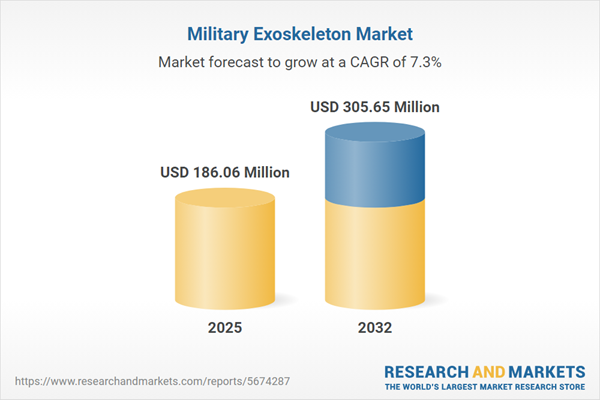Speak directly to the analyst to clarify any post sales queries you may have.
The military exoskeleton market has become a focal point for senior defense leaders, offering advanced solutions that align directly with operational priorities, force agility, and modernization objectives.
Market Snapshot: Military Exoskeleton Market Size and Growth
The global military exoskeleton market is projected to reach USD 186.06 million in 2025, up from an estimated USD 173.55 million in 2024, reflecting a compound annual growth rate of 7.33%. By 2032, the market size is expected to climb to USD 305.65 million. This acceleration is fueled by sustained investments in military modernization and scalable field deployment. Defense organizations are channeling resources into modular solutions and global collaboration, enabling streamlined cycles that respond to a variety of operational requirements. As a result, defense forces worldwide are experiencing improved flexibility, quicker technology readiness, and stronger mission response.
Scope & Segmentation of the Military Exoskeleton Market
- Wear Types: Lower limb exoskeletons optimize endurance, joint stability, and load-bearing capacity during extended patrols. Upper limb exoskeletons assist operators with substantial gear handling, minimizing fatigue and facilitating strenuous tasks that demand elevated arm and shoulder force.
- Technology Types: Active exoskeletons feature powered actuators and smart materials to enhance adaptability and support dynamic operations. Passive exoskeletons use mechanical assistance to ease the burden of lifting and repeated tasks, ideally suited for energy-limited conditions and broad field applications.
- Applications: Key uses include safe load transport, injury recovery support, reduction of chronic operator fatigue in continuous missions, and physical resilience enhancement for both training and live deployments.
- Geographical Coverage: Adoption trends vary by region, with notable advances in North America, Europe, Middle East, Africa, and Asia-Pacific. The United States, Germany, China, and South Korea lead technology integration, leveraging robust defense infrastructure and steady innovations to sustain capability growth.
- Companies Profiled: Leading industry participants encompass Lockheed Martin Corporation, Raytheon Technologies Corporation, Sarcos Technology and Robotics Corporation, Ekso Bionics Holdings Inc., CYBERDYNE Inc., Northrop Grumman Corporation, Thales S.A., Hyundai Rotem Company Limited, Yaskawa Electric Corporation, and German Bionic Systems GmbH. Each company sustains a focus on operational effectiveness and seamless integration through ongoing research and development.
Key Takeaways for Senior Decision-Makers
- The evolution of robotics and biomechanics broadens military exoskeleton use cases, helping organizations meet a spectrum of deployment scenarios with heightened mission agility.
- Integration of artificial intelligence and adaptive biometrics within exoskeletons delivers customized support for individual operators, promoting mission completion and supporting effective post-mission recovery.
- Balanced procurement strategies focus on both operational performance and enduring personnel welfare, supporting resilient and healthy military workforces.
- Collaborative programs involving defense, technology, and research sectors advance the pace of product development while maintaining critical compliance with operational benchmarks and evolving regulations.
- Emphasizing national supply chains decreases exposure to global uncertainties and maintains readiness as geopolitical climates fluctuate.
Tariff Impact on Military Exoskeleton Supply Chains
Recent tariff implementations in the United States are strengthening the priority for domestic sourcing of core exoskeleton components, including actuators and sensors. This encourages deeper partnerships with regional suppliers and increases overall supply chain resilience. To address compliance and reduce delivery risk, companies are investing in workforce upskilling and facility enhancements aligned with regulatory changes.
Methodology & Data Sources
This report is grounded in quantitative market research, in-depth interviews with procurement leaders, technical expert consultation, literature reviews, patent analysis, and official references from defense organizations. The approach ensures each trend and procurement practice is validated within the military exoskeleton sector.
Why This Report Matters
- Equips decision-makers to refine investment strategies and develop procurement approaches aligned with evolving defense sector directions.
- Prepares leadership for changes in international and domestic regulations, supporting robust operational continuity and resilience against supply chain disruptions.
- Highlights opportunities for collaborative partnerships across defense, technology, and research, fostering a culture of ongoing innovation and competitive market presence.
Conclusion
Military exoskeletons are setting new benchmarks in defense operations. This analysis delivers clear insights for leaders seeking to enhance procurement effectiveness and technological deployment for future operational demands.
Additional Product Information:
- Purchase of this report includes 1 year online access with quarterly updates.
- This report can be updated on request. Please contact our Customer Experience team using the Ask a Question widget on our website.
Table of Contents
3. Executive Summary
4. Market Overview
7. Cumulative Impact of Artificial Intelligence 2025
Companies Mentioned
The companies profiled in this Military Exoskeleton market report include:- Lockheed Martin Corporation
- Raytheon Technologies Corporation
- Sarcos Technology and Robotics Corporation
- Ekso Bionics Holdings, Inc.
- CYBERDYNE, Inc.
- Northrop Grumman Corporation
- Thales S.A.
- Hyundai Rotem Company Limited
- Yaskawa Electric Corporation
- German Bionic Systems GmbH
Table Information
| Report Attribute | Details |
|---|---|
| No. of Pages | 193 |
| Published | October 2025 |
| Forecast Period | 2025 - 2032 |
| Estimated Market Value ( USD | $ 186.06 Million |
| Forecasted Market Value ( USD | $ 305.65 Million |
| Compound Annual Growth Rate | 7.3% |
| Regions Covered | Global |
| No. of Companies Mentioned | 11 |









